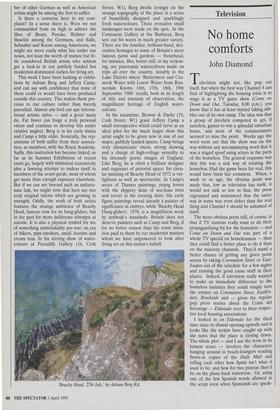Exhibitions
Adrian Berg: a Sense of Place (Barbican Concourse Gallery, till 17 April) Adrian Berg: the South Coast (Piccadilly Gallery, till 17 April) Jeffery Camp: Paintings and Drawings 1950-1993 (Browse & Darby, till 24 April)
Recognition and repute
Giles Auty
In recent years, it has become a regular feature of the publicity sent out by Britain's major, publicly funded galleries to describe artists whom their managements elect to exhibit as being widely or even universally `acknowledged' to be among the most Important or influential in their countries or eras. Merely the most recent example of this habit is from the Tate Gallery, Liver- pool, which describes the late Joseph Eeuys baldly in a publicity handout as 'one of the most influential artists of our century'.
The quarrel I have with this kind of writ- ing is that often those doing the 'acknowl- edging' are, in reality, very few in number. Such acknowledgers may and often do regard their own opinions as being of infinitely greater value than those of the rest of the thinking population, but this does not validate their claims. Were you to conduct a survey among the citizens of Liv- erpool, you would find the percentage of those who have even heard of Joseph Beuys would be low, verging on the minus- cule. Even among those who are aware of him, including artists in general, at least as many view him as a sham than as a shaman. Nor would this last be hard to ver- ify.
The true, if hidden purpose of such writ- ing is first to intimidate the public, second, to ensure a continuing healthy price level and market in the artist in question's arti- facts and, third, to be self-fulfilling. As part of a commercial conspiracy, such writing is effective, but 1 have to ask whether this is a correct, let alone genuinely educational role for publicly funded galleries to be Playing? Were appreciation of art to be dependent once more on looking and thinking rather than the hyperbole of pub- licists, the reputations of Beuys and a num- ber of other German as well as American artists might be among the first to suffer.
Is there a converse here to my com- plaint? In a sense there is. Were we not commanded from on high to admire the likes of Beuys, Pencke, Richter and Baselitz among the Germans, and Salle, Schnabel and Koons among Americans, we might see more easily what lies under our noses, not least the worth of mature but lit- tle considered British artists who seldom get a look-in in our publicly funded but modernist-dominated outlets for living art.
This week I have been looking at exhibi- tions by Adrian Berg and Jeffery Camp, and can say with confidence that none of these could or would have been produced outside this country. This makes them pre- cious to our culture rather than merely parochial. Almost any fool can ape interna- tional artistic styles — and a great many do. Far fewer can forge a truly personal vision and continue to develop this under relative neglect. Berg is in his early sixties and Camp a little older. Ironically, the rep- utations of both suffer from their associa- tion, as members, with the Royal Academy. Sadly, this institution has become linked, so far as its Summer Exhibitions of recent years go, largely with whimsical eccentricity plus a fawning attempt to endear itself to members of the avant-garde, most of whom get more than enough exposure elsewhere. But if we can see beyond such an unfortu- nate link, we might note that here are two truly original talents which are growing in strength. Oddly, the work of both artists features the strange ambience of Beachy Head, famous now for its hang-gliders, but in the past for more deliberate attempts at suicide. It is also a physical symbol for me of something unmistakably pre-war: an era of hikers, pipe-smokers, small Austins and cream teas. In his stirring show of water- colours at Piccadilly Gallery (16, Cork Street, W1), Berg dwells lovingly on the strange topography of the place in a series of beautifully designed and sparklingly fresh watercolours. These evocative small landscapes were made on the spot. At the Concourse Gallery at the Barbican, Berg sets out his wares in much greater variety. There are the familiar, brilliant-hued, dec- orative homages to some of Britain's more famous parks and gardens — Stourhead, for instance. But, better still, in my reckon- ing, are panoramic watercolours made on trips all over the country, notably in the Lake District where `Buttermere and Cni- mock Water with Lower Water from Ran- nerdale Knotts 16th, 17th, 18th, 19th September 1988' recalls, both in its length of title and intensity of observation, the magnificent heritage of English water- colours.
In the meantime, Browse & Darby (19, Cork Street, W1) grant Jeffery Camp a small retrospective which could serve as an ideal pilot for the much larger show this artist ought to be given now in one of our major, publicly funded spaces. Camp brings truly idiosyncratic vision, strong drawing and a charge of high-voltage sexuality to his intensely poetic images of England. Like Berg, he is often a brilliant designer and organiser of pictorial space: his circu- lar painting of Beachy Head of 1972 is ver- tiginous as well as spectacular. In Camp's series of Thames paintings, young lovers with the slippery skins of sea-lions twist and cavort in the evening skies. His early figure paintings reveal already a painter of significance in embryo, while `Beachy Head Hang-gliders', 1978, is a magnificent work by anybody's standards. Britain does not deserve painters such as Camp and Berg, if for no better reason than the scant atten- tion paid to them by our modernist masters whom we have empowered to look after living art on this nation's behalf.
`Beachy Head, 27th July, by Adrian Berg RA



















































 Previous page
Previous page